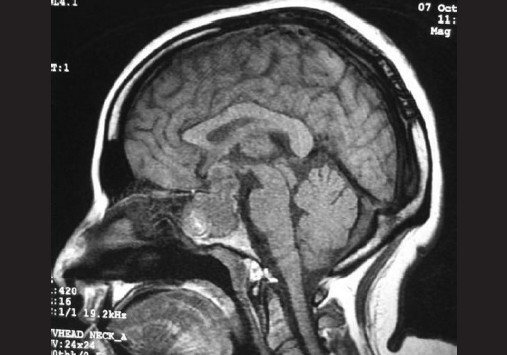Abstract
Dengue hemorrhagic fever leading to hemorrhage in pituitary adenoma is not reported till date: We herein report the first case of bilateral visual loss secondary to pituitary adenoma hemorrhage associated with dengue hemorrhagic fever. Urgent transnasal trans sphenoidal decompression of the macroadenoma prevented permanent visual loss in this patient. Pituitary apoplexy should be considered as differential diagnosis of visual deterioration apart from retinal hemorrhage, maculopathy, and optic neuropathy in cases of dengue hemorrhagic fever. Early decompression of optic nerves helped in the restoration of vision.
Keywords: Dengue hemorrhagic fever, pituitary apoplexy, pituitary tumor hemorrhage, reversible bilateral vision loss
Dengue hemorrhagic fever may cause low platelet counts, but a case leading to apoplexy in pituitary adenoma is not reported in literature till date. Here one interesting case of pituitary apoplexy due to dengue fever and low platelet count has been described. The differential diagnosis and management has been discussed.
Case Report
A 31-year-old Indian woman, with a history of hypothyroidism (on levothyroxine tablets 100 μg/day) presented with a history of fever of 104°F of 5-day duration to the Department of Internal Medicine; investigations done at a laboratory of Paras Hospital, Gurgaon, showed low platelet counts (45,000/cumm) with positive dengue serology both immunoglobulin G and M). One day after admission in the hospital, she had sudden loss of vision in both eyes with headache and vomiting. On neurosurgery consultation, she was conscious, oriented with bilateral complete loss of vision (no perception of light) and no direct or consensual light reflex with a pupil size of 4 mm in diameter. Optic disc/retinal examination of both eyes was normal. Rest of the neurological exam was normal; magnetic resonance imaging (MRI) of the brain revealed pituitary macro adenoma of 16 × 22 mm size with evidence of acute hemorrhage (iso- to hyperintense on T1 and hypointense on T2) with enhancement of the tumor on contrast [Fig. 1]. Serum prolactin was 11.68 ng/ml (normal 4-30 ng/ml) and serum thyroid stimulating hormone (TSH) was 4.649 μIU/ml (normal 0.3–3.0 μIU/ml) on thyroxin replacement therapy. Urgent transnasal trans sphenoidal decompression of the macroadenoma was done, after replacing platelets (>100,000/cumm). Intraoperatively, there was evidence of bleed inside the tumor. There was progressive improvement in vision from the second postoperative day till 3 months. Vision was 20/60 and 20/40 in the right and left eye, respectively, with residual bilateral temporal field defects after 3-month follow-up.
Figure 1.

Contrast-enhanced T1-weighted saggital scan showing pituitary tumor with hemorrhage
Discussion
Dengue hemorrhagic fever is one of the causes of low platelet count leading to petechial rash and spontaneous bleeding from mucosal surfaces. Pituitary apoplexy is spontaneous hemorrhage into the pituitary adenoma. Our case was a patient diagnosed with dengue hemorrhagic fever with a low platelet count without any rash or systemic bleeding. This patient had sudden loss of vision with headache. MRI of the brain revealed pituitary macroadenoma with apoplexy. This catastrophe had arisen due to bleeding into the pituitary adenoma, probably predisposed by the low platelet count due to dengue hemorrhagic fever. In medical literature, this association has never been reported. By pointing out this rare association, authors want to emphasize that a low platelet count due to dengue hemorrhagic fever may cause pituitary adenoma apoplexy. Under this condition, the patient may present with sudden loss of vision with headache. MRI of the brain should be done and pituitary hormones levels should be checked to rule out pituitary apoplexy. Other causes of visual deterioration in patients with dengue fever are optic neuropathy, maculopathy, retinal capillary occlusion, foveolitis, and retinal hemorrhage.[1] If the diagnosis is made in time, urgent treatment in the form of decompression of optic nerves through transnasal trans sphenoid route may help to save vision as in the presented case.
References
- 1.Sanjay S, Wagle AM, Au Eong KG. Optic neuropathy associated with dengue fever. Eye. 2008;22:722–4. doi: 10.1038/eye.2008.64. [DOI] [PubMed] [Google Scholar]
- 2.Siqueira RC, Vitral NP, Campos WR, Oréfice F, de Moraes Figueiredo LT. Ocular manifestations in Dengue fever. Ocul Immunol Inflamm. 2004;12:323–7. doi: 10.1080/092739490500345. [DOI] [PubMed] [Google Scholar]
- 3.Su DH, Bacsal K, Chee SP, Flores JV, Lim WK, Cheng BC, et al. Prevalence of dengue maculopathy in patients hospitalized for dengue fever. Ophthalmology. 2007;114:1743–7. doi: 10.1016/j.ophtha.2007.03.054. [DOI] [PubMed] [Google Scholar]


